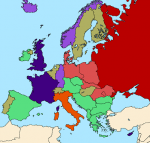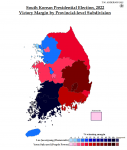I had an idea last night for a US/USSR swapped end of Cold War setup, where the modern US successor state resembles OTL Russia (or how Russia sees itself). Unfortunately, it really needs a wikibox and I don't know how to make them properly, but here's a rough sketch:
View attachment 50023
Now there is a problem that the geography doesn't really work: Canada is the obvious analogue for NATO/the EU expanding into territories that became independent after the fall of the Union, but a lot of the US territories that best fit the 'stans of Central Asia border Canada rather than Mexico (which is China in this analogue). Minnesota is also put in an awkward position, as culturally it seems to fit with states that might want to join Canada, yet its location next to the 'stan states doesn't fit. I may need to rethink that. The other problem was what to make Ukraine: I was going to do California, with San Diego being the Crimea, but then I changed it to Michigan as the UP seems a better 'rhyme' for Crimea. I can't decide which is better - San Diego fits the naval base thing, but on the other hand would making California Ukraine be like implying Russia has lost Vladivostok - ugh.
Also I made Georgia Georgia because come on, who wouldn't, and Florida is supposed to be Armenia and Azerbaijan. Texas is Belarus, New Mexico and Arizona are supposed to be examples of 'stans which now look more towards China than Russia.
(Red = American Federation, light red = independent states aligned with the AF, mid-red = areas occupied by the AF or unrecognised republics backed by the AF, green = Mexico, light green = independent states increasingly more aligned with Mexico, dark blue = North American Union né Canada, light blue = independent states wishing to join the NAU, grey = other states).
edit: I'm now realising I should have put in something to represent Moldova and Transnistria, hmm.



















